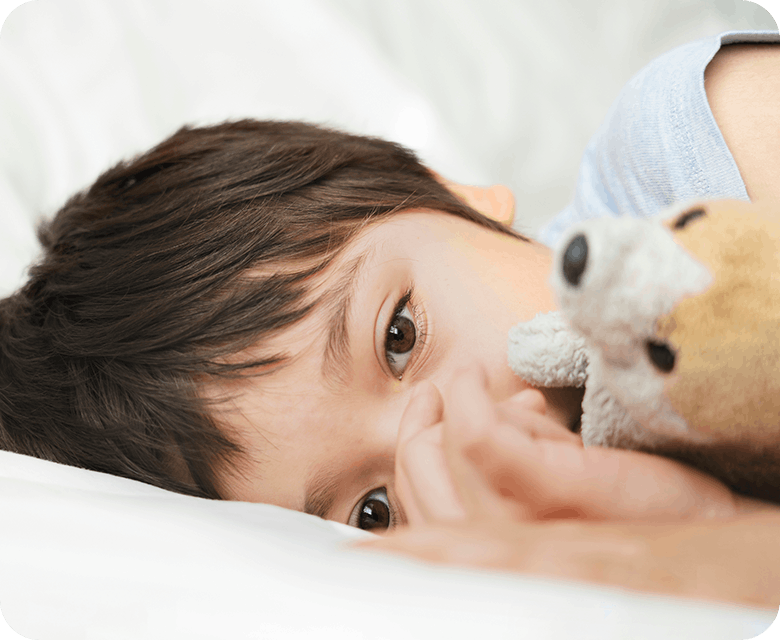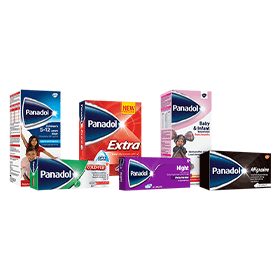The term ‘growing pains’ may be a misnomer, but the aching limbs children sometimes feel are very real. Learn about the symptoms of growing pain in children, what causes it and how to help them feel better.
Growing pains:
what are they and how can you help?
Growing pains is the term commonly used to describe the achy legs children can sometimes feel, often at night. It’s usually nothing to be worried about, but you’ll naturally want to understand what your child is experiencing, why it’s happening and how you can help ease their pain.1
The 3 biggest problems with growing pains:
1. They hurt: Your child is experiencing real discomfort.
2. They disrupt sleep: Your little one may be grumpy and tired during the day.
3. They're vague: Reported aches vary and the causes aren’t well understood7.

What are the symptoms of growing pain in children?
If your child is experiencing growing pains, they will most likely complain of achy legs, and usually at night. The pain, however, can also affect their arms and even cause tummy aches and headaches.3 Although the symptoms most often occur during the night, they can disrupt your child’s sleep, causing tiredness the next day.
How can I tell if it’s growing pains or something else?
Growing pains, while uncomfortable, aren’t dangerous. But other conditions that can cause pain in children might be, so pay attention to what they’re telling you. Always err on the side of caution and consult a doctor.
Pain symptoms that may indicate growing pains:
- The pain is concentrated in the muscles and in their legs—usually in the calf, the front of their thigh, or behind their knee5.
- The pain isn’t eased by changing position.
- Their pain comes on towards the end of the day and is worse at night.
- The pain isn’t constant but comes and goes, often with days or weeks between episodes.
- The pain may be bad enough to wake your child or stop them from falling asleep.
- The pain is usually gone in the morning and during most of the day.
- Sometimes the pain can be in their arms, stomach, or head but follows the same patterns as above3.
Indications it might may be something different:
- The pain is severe or only felt on one side (one leg or one arm).6
- The pain doesn’t go away in the morning.6
- They also have redness or swelling in the affected limb.
- They’re limping or they’ve recently been injured.6
- Their pain is focussed in their joints.7
- They also have other symptoms such as rash, fever, weakness, fatigue, or poor appetite.7
- Their symptoms are disrupting their usual daily activities.7
What causes growing pain in children?
Some think growing pains might be related to restless legs syndrome, a disorder characterised by unpleasant sensations in the legs and an urge to move them. The leading say perhaps it’s down to too much physical activity during the preceding day. The short answer is that no one really knows.8
Contrary to popular opinion, what we call growing pains typically don’t happen during periods when your child is growing the most. Even during growth spurts, bones don’t grow quickly and the process shouldn’t cause any pain.8

What are the possible explanations for growing pains?
There are a few theories about why your child might feel growing pain on and off from two years old until they hit the teen years. These include11:
- Problems with their posture or stride. If they’re sitting or standing with poor posture or walking or running with an unbalanced step, your child may be pulling muscles as their body strains.
- Playing too hard. Physical activities like running and jumping can be jarring to your child’s developing muscles and bones10.
- Emotional problems. If your child is upset about something, stressed out, or unhappy for some reason, it could potentially manifest as aches and pains.

Is there a treatment for muscle ache in children?
Because there’s no specific cause of growing pains, there’s no set cure or treatment either10. The good news, however, is that there are several ways you can help make a child with minor muscle aches more comfortable and ease their pain. These range from simple home remedies to over-the-counter pain-relief medications, such as Children’s Panadol.
How can I ease my child’s growing pains?
While you can’t stop the growing pains from happening, there are a few things you can do to stop muscle aches hurting so much12:
- Cuddles: Don’t underestimate the power of tender loving care to make everything better. Sometimes just having some quality time on your lap will make your little one start to feel better.
- Massage: Take the cuddle up a notch and combine it with a gentle massage of the affected limbs.
- Stretching: Depending on your child’s age, either gently stretch their limbs or show them how to do it themselves. Older children might enjoy learning yoga to take control of their own physical wellbeing.
- Heat: To relax their muscles, give your child a warm bath before bedtime or a hot water bottle to take to bed.
- Posture: Ask your child’s doctor to check their posture and stride.
- Pain medicines: Paracetamol, such as Children’s Panadol, and ibuprofen can be used to relieve muscle aches. Always follow the packaging dosage guidelines for your child’s age and weight and ask your pharmacist if you’re unsure.
Don’t give them more than one medicine containing paracetamol and never give aspirin to a child under 16 unless instructed to do so by a doctor.13

When will it get better?
Your child might experience growing pains for only a short time or on and off for a period of several years.14 The aches generally tend to stop by the onset of the teenage years—just as your child is developing an entirely new, hormone-related set of issues to deal with!
Your job as a parent may never be finished but rest assured that help and advice are always available.









